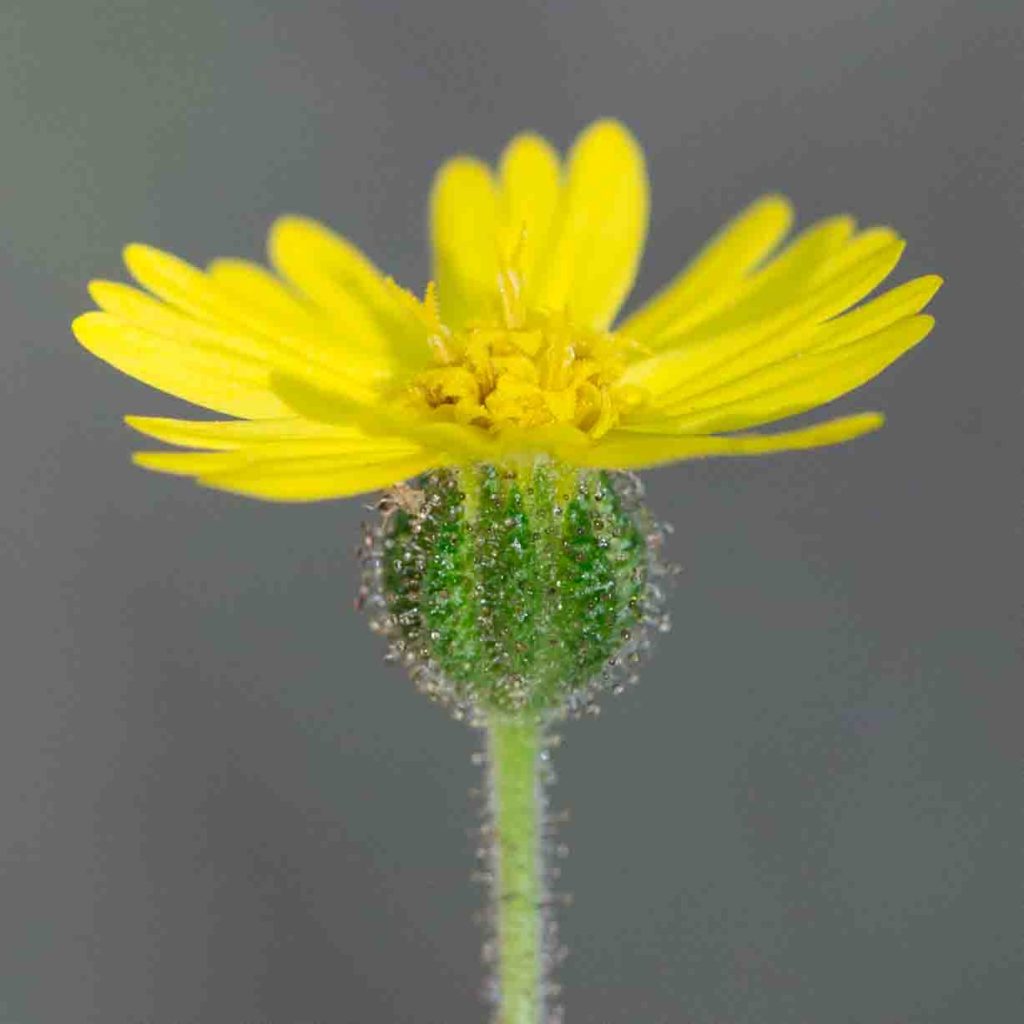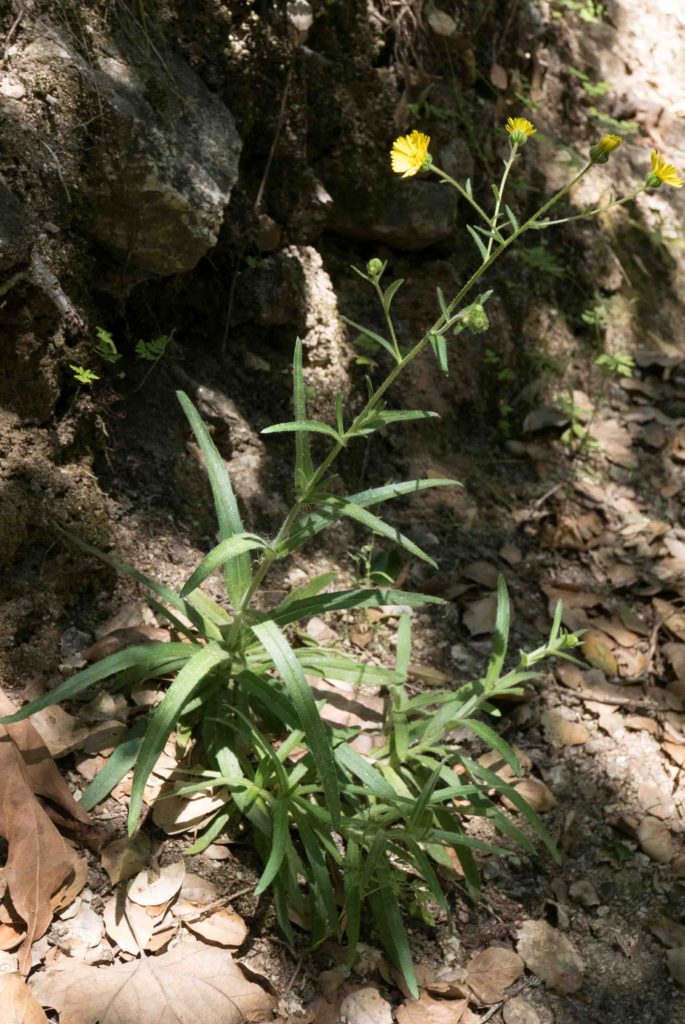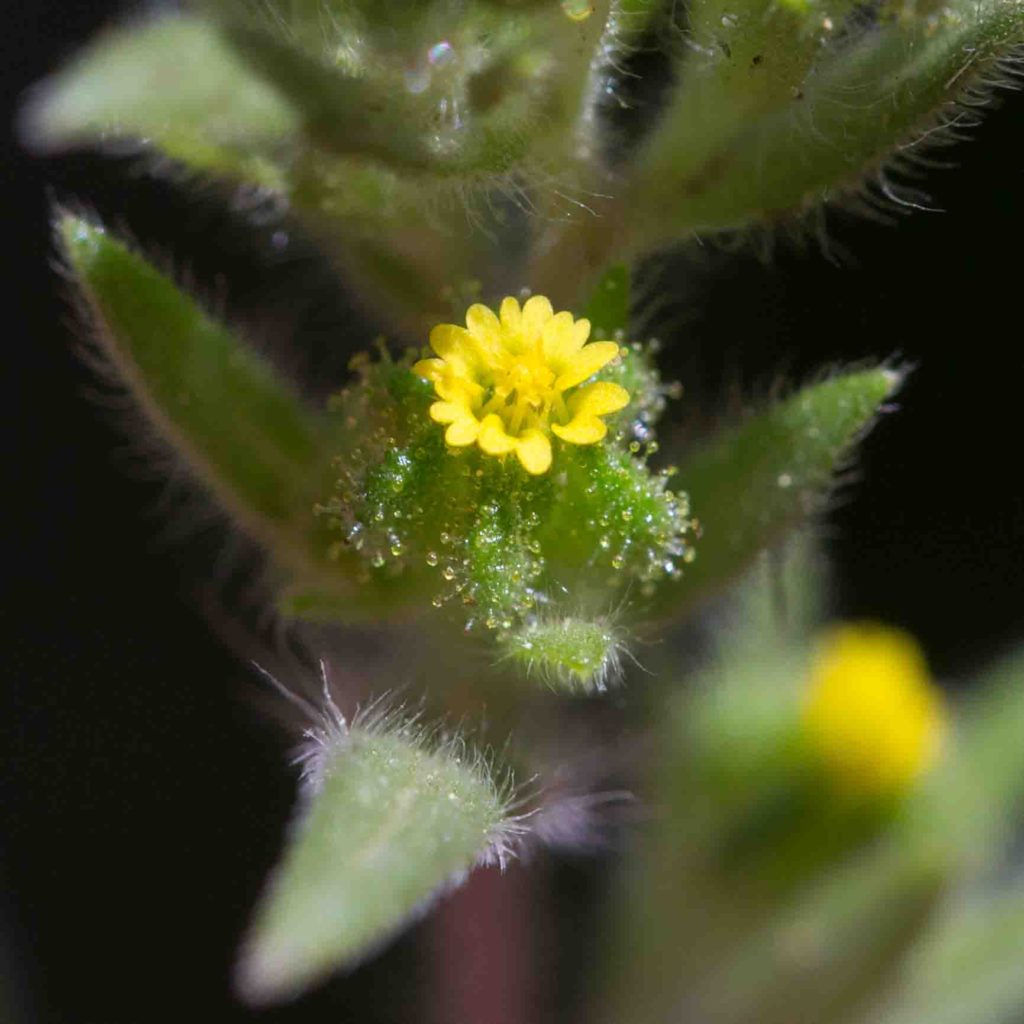Asteraceae: Sunflower Family – Heliantheae (Sunflower) Tribe: Madia
The Sunflower family is a very large family with over 25,000 members. Botanists subdivide the family into a number of tribes, of which 14 are present in Monterey County. One of these, the Heliantheae or Sunflower tribe, is further broken down into subtribes, of which 9 are present. The Madia (Tarweed) subtribe includes some which have conspicuous glands, giving off a distinct, tarry odor. This page covers the Madia genus, and a plant that was formerly included within it.
Woodland Tarweed / Madia – Anisocarpus madioides
Blooms:
Apr–Sept
Plant Height:
15–75 cm
Flower Size:
Medium
Origin:
Native
Habitat:
Moist coniferous or mixed woodland
Notes:
A shade-loving relative of the Madias, this has fewer heads than Slender Tarweed (Madia gracilis, see below), and the buds are more rounded. The 7–15 ray flowers are deeply 3-lobed, so that each one could seem to be 3 separate flowers. Stamens are yellow, or brown with yellow anthers. The plant is often loosely branched, with inflorescences at the tip of each branch. Cauline leaves are opposite towards the base of the plant, but alternate towards the top. There is also a basal rosette of coarsely hairy, slightly toothed, 5–10 cm leaves. The current scientific name is an improvement on the old — Madia madioides which, when translated means “the Madia-like Madia” — as unhelpful a name as one could find.
Common Madia – Madia elegans
Blooms:
Apr–Nov
Plant Height:
0.6–2.5 m
Flower Size:
Large
Origin:
Native
Habitat:
Grassy, open or disturbed areas
Notes:
This is a beautiful, extremely common flower of mid- to late-summer. The plant has a pungent odor and, like other tarweeds, is sticky to the touch. It is extremely variable, having between 5 and 21 ray flowers. The ray flowers tend to be pure yellow earlier in the year, but develop a maroon base later in the season. The flowers are at their best in the morning, often withering or closing during the afternoon.
Small Tarweed – Madia exigua
Blooms:
Apr–July
Plant Height:
5–30 cm
Flower Size:
Very small
Origin:
Native
Habitat:
Dry grassland & woodland
Notes:
This small flower is aptly named, and its size distinguishes it from the other tarweeds. It is easily overlooked. The stem is slender, with glandular hairs. The involucre is top-shaped, and coated in knobby yellow glands. Each inflorescence has 5–8 tiny ray flowers, no more than 1 mm long and 1 yellow disk flower (occasionally 2).
Slender Tarweed – Madia gracilis
Blooms:
Apr–Aug
Plant Height:
15–100 cm
Flower Size:
Medium
Origin:
Native
Habitat:
Open areas and wooded hillsides
Notes:
Quite variable in appearance, the flower heads appear either in open panicles or in tight raceme-like clusters. It can be difficult to distinguish from Coast Tarweed (Madia sativa, see below). However, it has only 3–10 ray flowers and 2–16 disk flowers, compared to 8-13 ray flowers and 11–14 disk flowers for Coast Tarweed. Its ray flowers also can be larger; 1.5–8 mm long (compared to 1.5–4 mm for Coast Tarweed). Another difference is that the Slender Tarweed is glandular hairy only towards the top part of the stem and has a citrus fragrance; while Coast Tarweed is glandular hairy throughout, and is strongly ill-scented.
Coast Tarweed – Madia sativa
Blooms:
May–Oct
Plant Height:
35–100 (240) cm
Flower Size:
Small
Origin:
Native
Habitat:
Coastal grassland
Notes:
This can be quite variable in appearance, with flower heads sessile or short-peduncled, often in dense clusters. It can be difficult to distinguish from Slender Tarweed (Madia gracilis, see above), but it has (usually) 8– 13 ray flowers and 11– 14 disk flowers. Also, its ray flowers tend to be smaller, no more than 4 mm long. Another difference is that Coast Tarweed is glandular hairy throughout, while Slender Tarweed is like that only towards the top part of the stem. The herbage is ill-scented and sticky. Although the plant is not usually more than 100 cm tall, it can occasionally be a very robust plant more than twice this height. Not to be confused with Coastal Tarweed (Deinandra corymbosa), whose flowers and growth habit are quite different.
























